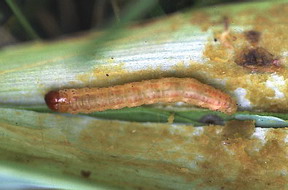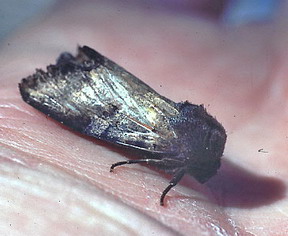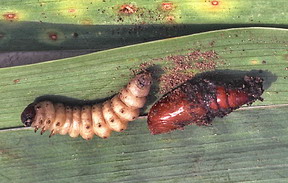|
The Iris Borer
|

What Does It Do?
The main clue to understanding and then controlling it, is in its name,
the Iris borer. The larva hatch from the eggs and immediately burrow into the inside of the Iris leaves. These leaves are naturally folded in two along their vertical axis, creating a wonderful natural tunnel for the borer to work in. The larva start from a small cut near the top of the leaf, (one of the identifiers used for controlling them,) and spend the early part of the summer eating their way down to the roots. Well actually they could care less about the actual root, it is the fleshy rhizome that attracts them. Once there they will completely hollow out the rhizome and what is left of the plant will topple over. The only good thing about this bug is that they are cannibalistic and only one larva from each batch of eggs will survive to make it as far as the rhizome.
What Can I Do?
There used to be a chemical control, Cygon, that was systemic. It was absorbed into the plants tissues and would kill the bug when it chomped. It is now banned in most places and no contact spray will work because you cannot get it into contact with the burrowing bug. Thus we have all been converted to organic gardeners. Not a bad thing. Now we have to be observant. Learn to watch for the indicative notch in the leaves where the bug enters. Watch for wet brown patches farther down the leaf as the bug hollows it out. It is sometimes difficult to cut out a whole fan of leaves to find the bug but remind yourself that he will destroy it himself if you leave him there.

How About The Adult?
The adult is a black and brown, night flying moth about 3-5 cm long, (pictured left sitting in my hand,)that is only interested in sex and is therefore hard to hurt unless you can imitate the opposite gender of iris borer moth on a mid summer’s evening.

He or she hatches out of a dark brown pupa that can be found in the soil around the affected plants (pictured right with a larva.) If you are digging up Iris to move and find the rhizomes hollowed out, dig around in the surrounding soil and you may find and destroy this 2 -4 cm long, bullet shaped beast.
The Most Important Step?
Clean up all of the Iris leaves and debris in the fall and dispose of them. The books say that the bug overwinters as eggs on this debris but I think it also can overwinter in the ground in the pupal stage particularly in more northern climates. When the eggs hatch and the tiny larva are wandering around looking for an Iris to attack, parasitic Nematodes can be applied that will attack and kill them. Regardless, cleanliness is the most important step in stopping the forward march of this destructive and ugly beast.
However; when the Iris show us their
spectacular blooms
they do banish all thoughts of the effort required to get there.
Get answers to your gardening questions by subscribing to
Ken’s free newsletter, Dallying In The Dirt
return from Iris Borer to Bug main page
